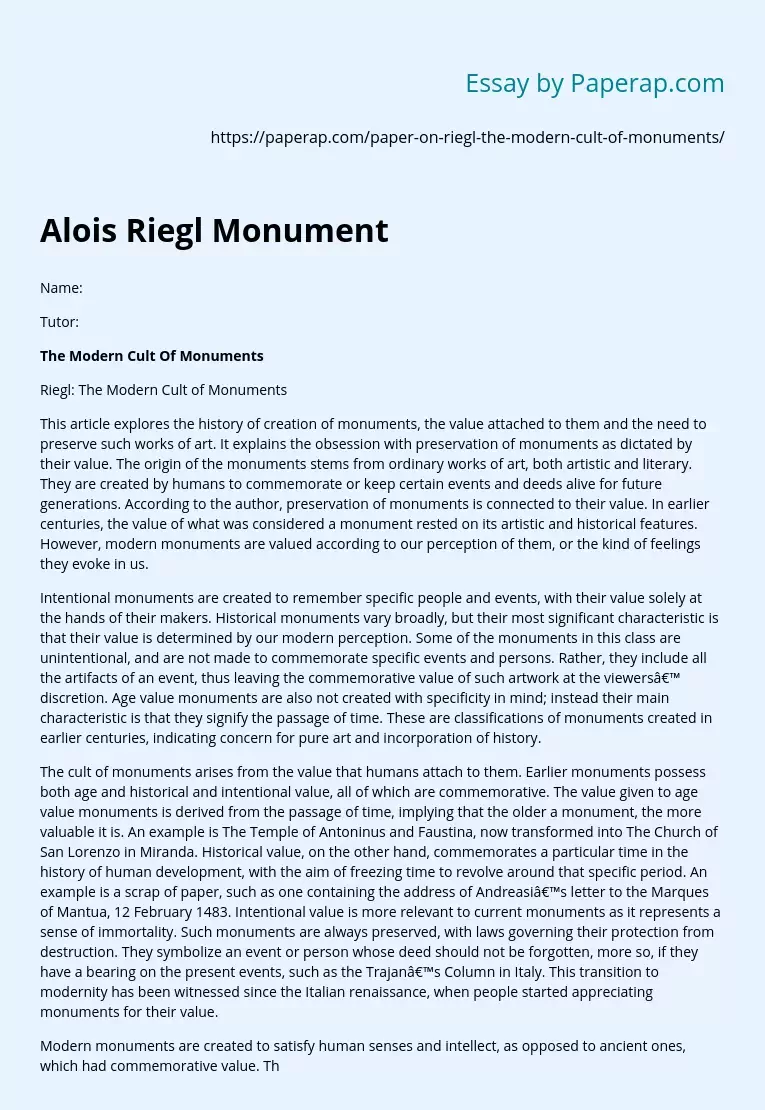The need to preserve the monuments of art
This article examines the history of the creation of monuments, their value and the need to preserve such works of art. This explains the obsession with preserving monuments for their value. The origin of the monuments is associated with ordinary works of art, both artistic and literary. They are created by humans to commemorate or preserve certain events and deeds for future generations. According to the author, the preservation of monuments is associated with their value. In previous centuries, the value of what was considered a monument was in its artistic and historical features.
However, modern monuments are valued according to our perception of them or the feelings that they evoke in us.
Intentional monuments are created to remember specific people and events, and their value is solely in the hands of their creators. Historic monuments vary greatly, but their most important characteristic is that their value is determined by our modern perception. Some monuments of this class were created unintentionally and not in memory of specific events and people.
Rather, they include all the artifacts of the event, thus leaving the memorable value of such works of art to the discretion of the audience. Monuments of age value are also not created taking into account the specifics; instead, their main characteristic is that they represent the passage of time. This is a classification of monuments created in earlier centuries, indicating a concern for pure art and the inclusion of history.
The cult of monuments stems from the value that people attach to them.
Earlier monuments have both age and historical and deliberate value, all of which are memorable. The age value of monuments is determined over time, which means that the older the monument, the more valuable it is. An example is the Temple of Antoninus and Faustina, now converted to the Church of San Lorenzo in Miranda. On the other hand, historical value reflects a specific period in the history of human development with the aim of freezing time in order to revolve around that specific period. An example would be a piece of paper, such as containing the address of Andreasi’s letter to the Marquis of Mantua on February 12, 1483. Intentional value is more relevant to current monuments as it represents a sense of immortality. Such monuments are always preserved, and laws governing their protection from destruction are in force. They symbolize an event or a person whose deed should not be forgotten, especially if they are related to current events, such as Trajan’s Column in Italy. This transition to modernity has been observed since the Italian Renaissance, when people began to value monuments for their value.
Modern monuments were created to satisfy human feelings and intellect, in contrast to the ancient ones, which had a memorable value. The cult of monuments has evolved from a commemorative value to a focus on artistic value. This means that they survived for different reasons than in previous centuries. For example, the emphasis has shifted to consumer value, art value and novelty value, while attention is also paid to the secular and religious value of monuments.
An example is the painting by Fritz von Ude “Let the Children Come to Me”, which Catholics call secular. Monuments are preserved because of their practicality expressed in terms of service value, including the dome of St. Peter’s in Rome. It is this aspect of practicality that motivates conservation. The value of novelty is aimed at making the monument look as fresh as it was when it was created. This contradicts the earlier cult of age value, according to which the uniqueness of the monument is explained by its old age. Obviously, modern monuments are more aesthetically pleasing than before and may lose their cultural value over time.
In the words of the author: “Thus, we also require that old monuments have the appearance of a (fresh) artifact, that is, they make a complete and pristine impression (Riegl 21).” This sums up the modern cult of monuments, the struggle to preserve not the cultural or historical value, but the aesthetic value of monuments. This sums up the modern cult of monuments, the struggle to preserve not the cultural or historical value, but the aesthetic value of monuments.
Is our current abundance of monuments, without a well-defined style or the use of culturally understood symbolism, an indicator of the loss of a clear cultural understanding that art and history are important attributes involved in the creation of a monument?
It is true that there is no specific style and cultural symbolism in our current abundance of monuments. This is because there is more emphasis on beauty, hence the desire to revive some works of art. This happens without taking into account the historical and artistic value of the monuments. Contemporary monuments are intended to please the eye, not for memorial purposes.
Works cited
- Rigl, Alois. The modern cult of monuments: its nature and origin. Cambridge (Massachusetts: MIT Press, 1982. Print.
The need to preserve the monuments of art. (2019, Dec 05). Retrieved from https://paperap.com/paper-on-riegl-the-modern-cult-of-monuments/

